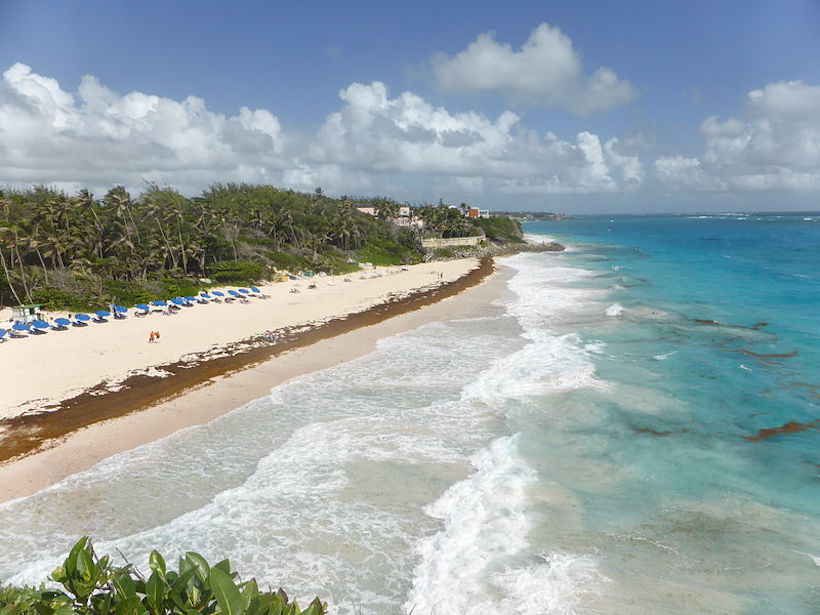In 2011, unprecedented amounts of Sargassum seaweed suddenly began to proliferate on Caribbean beaches, causing destruction and panic.
Scientists associated the Sargassum bloom with warming ocean temperatures and an increased release of nutrients (nitrogen and phosphorus) into the marine environment from land-based sources.
Besides Sargassum’s generally unwelcome appearance on pristine Caribbean shores, what has been even more significant are its economic and social ramifications.
Marie-Louise Felix, a lecturer in biology and environmental science at Sir Arthur Lewis Community College in Saint Lucia, said that one of the impacts of the Sargassum blooms has been on people’s health. In particular, Felix noted that “persons who did not have respiratory issues before are now complaining about respiratory issues.”
Sargassum toxicity describes high concentrations of hydrogen sulfide gas (released by Sargassum as it decomposes) leading to breathing difficulties, nausea, headaches, and skin rashes. Both residents and tourists have reported higher incidences of respiratory problems since the Sargassum blooms began.
Prolonged exposure to hydrogen sulfide also causes the oxidation of metals, which affects appliances and other electronics, Felix said. The east coast of Saint Lucia is particularly vulnerable to Sargassum beaching, for example, and Felix said many residents no longer have some of the basic comforts of modern living due to the seaweed. “People’s refrigerators, washing machines, and computers stopped working as the hydrogen sulfide gas mixed with the material and somehow caused damage to the electronics. Persons have had to change their televisions, two or three times in a year, and [many] ultimately give up on purchasing this equipment because of the constant damage caused.”
The toll on electronics has also affected the region’s tourist economy, as resorts and hotels have had to invest in continual repairs to air conditioning units, televisions, corroded metals, and discolored paint.
Finally, Felix lamented that many residents have had to live with the foul odor emitted by the seaweed, which has also become a major disincentive for tourists. “Countries [in the Caribbean] have seen visitors canceling their reservations and shortening their stays at hotels because they are unable to enjoy the beach, which is what they primarily came to enjoy,” said Felix. In some cases, vacation cancelations have led to layoffs of local workers in the tourism industry.
Community and Government Solutions
While there has not been a single solution to the Sargassum problem, many individuals and organizations have attempted to manage the issue. “As the Sargassum comes in,” Felix said, “we come together as community groups to try to keep the beaches free [of the seaweed], which is very hard work, because what it means is raking of the beaches and raking what we can of floating material in the water.”
Several cleanup efforts have also been organized by federal and regional agencies. A report from the Caribbean Regional Fisheries Mechanism estimated that governments spent between US$1 million and US$7 million for cleanup, removal, and disposal of Sargassum in 2019. Critics of these efforts point to the exorbitant cost and damage done by heavy equipment to the region’s beaches.
Business Solutions
Twenty-seven-year-old Johanan Dujon, who has always had an interest in preserving the environment in his native Saint Lucia, was determined to find a better alternative. “I looked at how the authorities were handling the problem…and essentially they were spending a huge amount of money to pay for heavy equipment to destroy the beach, pick up Sargassum, and dump it in the landfill. This is unsustainable, and most islands [are] developing states [that] simply do not have the resources to pour millions of dollars into picking up seaweed.”
Dujon founded the company Algas Organics, which produces a Sargassum-based fertilizer. “We thought we could attain a niche for Sargassum fertilizer, and the end goal of all of this was to make sure every grain of Sargassum that would wash up on our beaches in Saint Lucia and the rest of the region would be used and processed, so that would create a new industry.”
“This shows the world that the Caribbean region is not just a place that you come to vacation.… We are just as innovative and can be as brilliant as those in Silicon Valley.”
The company offers employment opportunities for those in the fishing industry, which has been particularly devastated by Sargassum blooms. “We are creating alternative livelihood opportunities through Sargassum collection and processing for those unemployed persons.… So it is basically turning a climate change issue into a livelihood opportunity,” Dujon said. In addition, by employing people to manually collect the seaweed instead of having heavy equipment remove it, the company reduces impact to Saint Lucia’s beaches.
To deter any health impacts on his employees, Dujon said seaweed is collected when it is fresh. “We collect the seaweed fresh as soon as it rolls up to the shore. Staff use gloves, boots, and personal protective equipment to pick up the seaweed. Fresh Sargassum is harmless; the respiratory concerns and health concerns arise once Sargassum begins to decompose.”
Other innovative uses of Sargassum have emerged, from paper products to cosmetics to construction material. In Barbados, some residents think that the island’s enormous sugarcane industry could use Sargassum fertilizer. Perhaps most promising, there is ongoing research in the use of Sargassum as a biofuel.
Dujon says he is encouraged by solution-oriented initiatives like these.
“I am happy as to where we have gotten so far; this shows the world that the Caribbean region is not just a place that you come to vacation…. We are just as innovative and can be as brilliant as those in Silicon Valley and the other more developed parts of the world.”
—Sarah Peter (@SarahPeter3), Science Writer
Citation:
Peter, S. (2020), Saint Lucia works to release itself from Sargassum’s stranglehold, Eos, 101, https://doi.org/10.1029/2020EO149351. Published on 25 September 2020.
Text © 2020. The authors. CC BY-NC-ND 3.0
Except where otherwise noted, images are subject to copyright. Any reuse without express permission from the copyright owner is prohibited.

